Study on Low-Temperature Cracking Performance of Asphalt under Heat and Light Together Conditions
Abstract
1. Introduction
1.1. Background
1.2. Objectives
2. Materials
3. Low-Temperature Cracking Performance of Asphalt
3.1. Ductility Test
3.2. Bending Beam Rheometer (BBR) Test
3.3. Asphalt Composition Analysis Test
4. Conclusions
- (1)
- Under heat and light together, the ductility value of asphalt decreased with the increase of aging time, temperature, and ultraviolet intensity, and it became more obvious within 5 days; the ductility value of modified asphalt was significantly higher than that of base asphalt, and for the same modifier, the ductility value of modified asphalt for different base asphalts was also different, indicating that the asphalt cracking resistance was obviously reduced at the early stage. Moreover, it becomes worse with the increase of the aging time, temperature, and ultraviolet intensity, and the rational selection of base asphalt and modifier could improve the low-temperature cracking performance of asphalt.
- (2)
- Under heat and light together, the creep stiffness S value of asphalt was significantly increased, while the creep stiffness change rate m value of asphalt was obviously reduced with the increase of aging time. Meanwhile, the change rates of the S value and m value of modified asphalt were smaller than those of base asphalt. Hence, heat and light together aging could significantly weaken the low-temperature cracking resistance of asphalt, and they had less effect on the low-temperature cracking resistance of modified asphalt.
- (3)
- Under heat and light together, the content of asphaltenes increased significantly, while the content of aromatics clearly decreased with the increase of aging time. The change rates of asphaltenes and aromatics of modified asphalt were lower than those of base asphalt. Within 5 days of aging time, the four components content varied obviously, and as the aging time extended, their change rates slowed down.
- (4)
- The asphalt composition had a direct influence on its low-temperature cracking performance. Under heat and light together, whether the base asphalt or modified asphalt, the change trends of its ductility and component content were similar. Therefore, the ductility of asphalt aged by heat and light together for 15 days was suggested for use as the evaluation index of the low-temperature cracking performance of asphalt.
Author Contributions
Funding
Conflicts of Interest
References
- Rajbongshi, P.; Das, A. Estimation of temperature stress and low-temperature crack spacing in asphalt pavements. J. Transp. Eng. 2009, 135, 745–752. [Google Scholar] [CrossRef]
- Zhou, C.; Huang, B.; Shu, X.; Dong, Q. Validating MEDPG with tennessee pavement performance data. J. Transp. Eng. 2013, 139, 306–312. [Google Scholar] [CrossRef]
- Ma, H.; Wang, D.; Feng, D.; Wu, X. Verification of low temperature performance of asphalt pavement aging material in cold regions. J. Funct. Mater. 2015, 46, 24074–24077. [Google Scholar]
- Mao, C. Study on Crack Initiation Mechanism and Propagation Behavior of Asphalt Pavements. Ph.D. Thesis, Southwest Jiaotong University, Chengdu, China, 2004. [Google Scholar]
- Yan, Z. Study on the Cracking Mechanism and Prevention Measures of Top-down Crack on Flexible base Asphalt Pavement in Seasonal Frozen Area. Master’s Thesis, Chang’an University, Xi’an, China, 2013. [Google Scholar]
- Donna, H.; Scott, S.E.; Tim, A. Top-Down cracking in asphalt pavements: Cause, effects and cures. J. Transp. Eng. 2008, 134, 1–6. [Google Scholar]
- Wang, X. Analysis of Crack in Asphalt Pavement under the Ultraviolet Light Ageing. Master’s Thesis, Xi’an University of Architecture and Technology, Xi’an, China, 2014. [Google Scholar]
- Bagdat, T.; Boris, R. Predicting thermal cracking of asphalt pavements from bitumen and mix properties. Road Mater. Pavement Des. 2018, 19, 1832–1847. [Google Scholar]
- Behnia, B.; Buttlar, W.; Reis, H. Evaluation of Low-Temperature Cracking Performance of Asphalt Pavements Using Acoustic Emission: A Review. Appl. Sci. 2018, 8, 306. [Google Scholar] [CrossRef]
- Wu, S.; Ye, Y.; Li, Y.; Li, C.; Song, W.; Li, H.; Li, C.; Shu, B.; Nie, S. The Effect of UV Irradiation on the Chemical Structure, Mechanical and Self-Healing Properties of Asphalt Mixture. Materials 2019, 12, 2424. [Google Scholar] [CrossRef]
- Hesp, S.; Terlouw, T.; Vonk, W. Low temperature performance of SBS-modified asphalt mixes. Asph. Paving Technol. 2000, 69, 540–573. [Google Scholar]
- Kim, S.S.; Wysong, Z.D.; Kovach, J. Low-temperature thermal cracking of asphalt binder by asphalt binder cracking device. Transp. Res. Rec. 2006, 1962, 28–35. [Google Scholar] [CrossRef]
- Li, X.; Marasteanu, M.O.; Turos, M. Study of low temperature cracking in asphalt mixtures using mechanical testing and acoustic emission methods (With Discussion). J. Assoc. Asph. Paving Technol. 2007, 76, 427–453. [Google Scholar]
- Liu, T.; Hao, P. Comparison study of evaluation method for low temperature anti -cracking performance of hot mix asphalt. J. Tongji Univ. 2002, 30, 1468–1471. [Google Scholar]
- Pszczola, M.; Jaczewski, M.; Rys, D.; Jaskula, P.; Szydlowski, C. Evaluation of Asphalt Mixture Low-Temperature Performance in Bending Beam Creep Test. Materials 2018, 11, 100. [Google Scholar] [CrossRef] [PubMed]
- Zhou, J.; Zhang, Z.; Rao, X. Study on SHRP SBS modified asphalts’ anti-cracking characteristics. J. Chongqing Jiaotong Univ. 2005, 24, 50–52. [Google Scholar]
- Patrícia, H.; Leni, F.; Francisco, T.; Margareth, C.; Luciana, N.; Thaísa, F. Cracking resistance evaluation of asphalt binders subjected to different laboratory and field aging conditions. Road Mater. Pavement Des. 2019, 20, 663–677. [Google Scholar]
- Zhang, H.; Xu, G.; Chen, X.; Wang, R.; Kairen, S. Effect of long-term laboratory aging on rheological properties and cracking resistance of polymer-modified asphalt binders at intermediate and low temperature range. Constr. Build. Mater. 2019, 226, 767–777. [Google Scholar] [CrossRef]
- Glotova, N.; Kats, B.; Gorshkov, V. Photooxidation of asphalts in thin films. Chem. Technol. Fuels Oils 1974, 10, 876–879. [Google Scholar] [CrossRef]
- Zhang, D.; Zhang, H.; Shi, C. Investigation of aging performance of SBS modified asphalt with various aging methods. Constr. Build. Mater 2017, 145, 445–451. [Google Scholar] [CrossRef]
- Durrieu, F.; Farcas, F.; Mouillet, V. The influence of UV aging of a styrene/butadiene/styrene modified bitumen: Comparison between laboratory and on site aging. Fuel 2007, 86, 1446–1451. [Google Scholar] [CrossRef]
- Mouillet, V.; Farcas, F.; Besson, S. Ageing by UV radiation of an elastomer modified bitumen. Fuel 2008, 87, 2408–2419. [Google Scholar] [CrossRef]
- Liu, X.; Wu, S.; Liu, G.; Li, L. Optical and UV-Aging Properties of LDH-Modified Bitumen. Materials 2015, 8, 4022–4033. [Google Scholar] [CrossRef]
- Zhan, X.; Zhang, X.; Tan, Y.; Lu, L. Study on the low temperature performance evaluation indexes of modified asphalt. J. Highw. Transp. Res. Dev. 2007, 24, 42–45. [Google Scholar]
- Li, X.; Han, S.; Li, Y.; Li, B. Experimental study on index of low-temperature crack resistance of asphalt binder. J. Wuhan Univ. Technol. 2010, 32, 81–84. [Google Scholar]
- Huang, X.; Ismail Bakheit, E. Experimental study to determine the most preferred additive for improving asphalt performance using polypropylene, crumb rubber, and tafpack super in medium and high-temperature range. Appl. Sci. 2019, 9, 1567–1571. [Google Scholar]
- Lin, J.D.; Chen, S.H.; Liu, P.; Wang, J.N. Modified toughness used to evaluate the effect of polymer modified asphalt on Sma. J. Chin. Inst. Eng. 2004, 27, 8. [Google Scholar] [CrossRef]
- Menapace, I.; Yiming, W.; Masad, E. Chemical analysis of surface and bulk of asphalt binders aged with accelerated weathering tester and standard aging methods. Fuel 2017, 202, 366–379. [Google Scholar] [CrossRef]
- Li, W.; Fan, L.; Ling, L. Influence on performance of modified asphalt by SBS doping ratio. Shandong Jiaotong Keji 2009, 7, 35–37. [Google Scholar]
- Ding, Y.; Tan, D. Experimental research on pavement performance of SBS polymer modified bitumen. Build. Sci. 2012, 28, 3–46. [Google Scholar]
- ASTM D2872. Standard Test Method for Effect of Heat and Air on a Moving Film of Asphalt (Rolling Thin-Film Oven Test); ASTM International: West Conshohocken, PA, USA, 2019. [Google Scholar]
- Ran, L. Research on Aging Mechanism and High Performance Regenerant of SBS Modified Asphalt under Coupling Condition of Light, Heat, Water. Ph.D. Thesis, Chongqing Jiaotong University, Chongqing, China, 2016. [Google Scholar]
- Zhang, J. Research of Aging Characteristic of SBS Modified Asphalt under Coupling Condition of Heat and Light. Master’s Thesis, Chongqing Jiaotong University, Chongqing, China, 2014. [Google Scholar]
- Wang, M.; Gao, B.; Wu, Z.; Gou, J. Test research and application of rock asphalt composite modified asphalt SMA performance. Technol. Highw. Transp. 2014, 3, 29–40. [Google Scholar]
- China Ministry of Transport. JTG E20-2011 Specifications and Test Methods of Bitumen and Bituminous Mixtures for Highway Engineering; China Communications Press: Beijing, China, 2011.
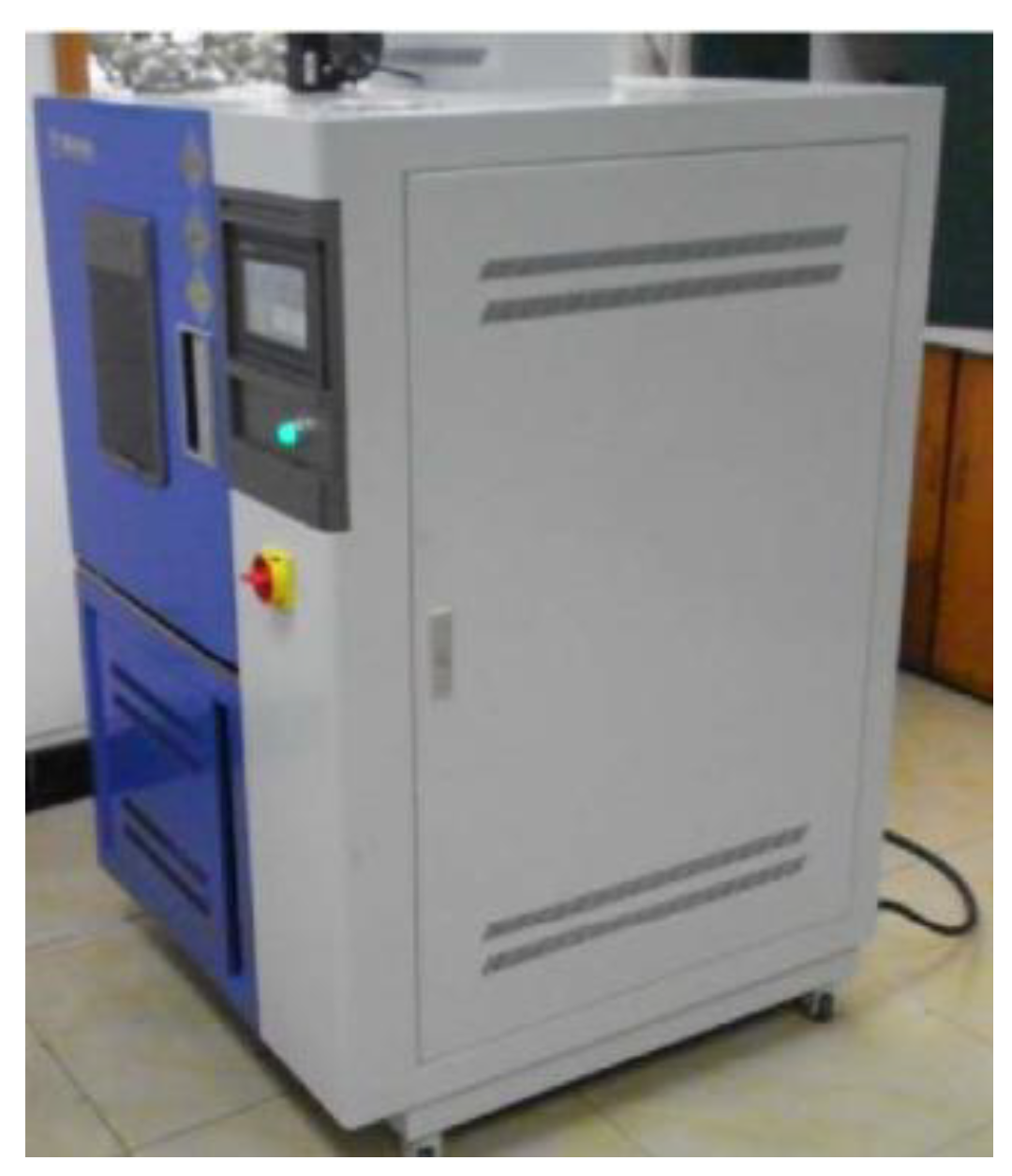
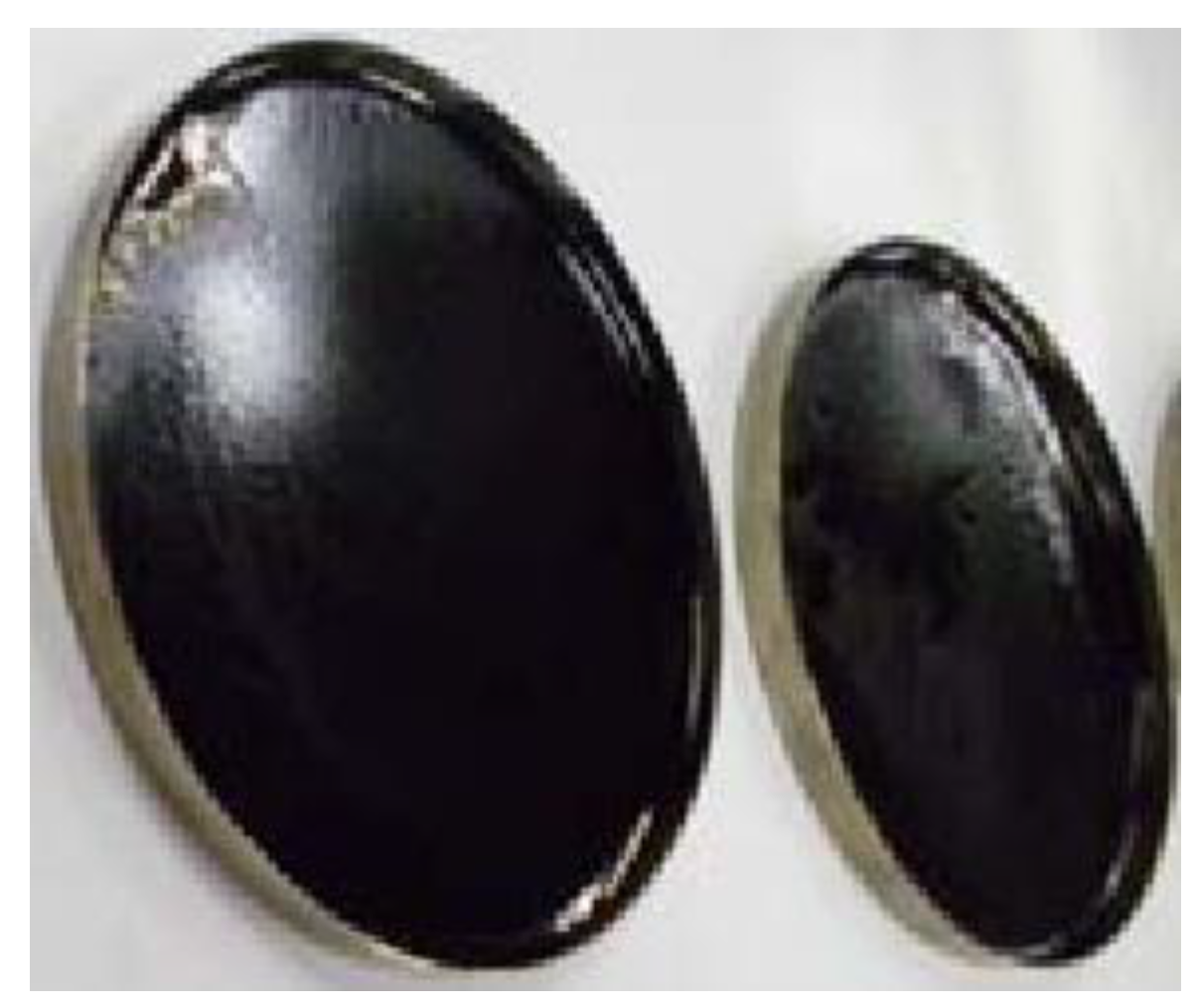
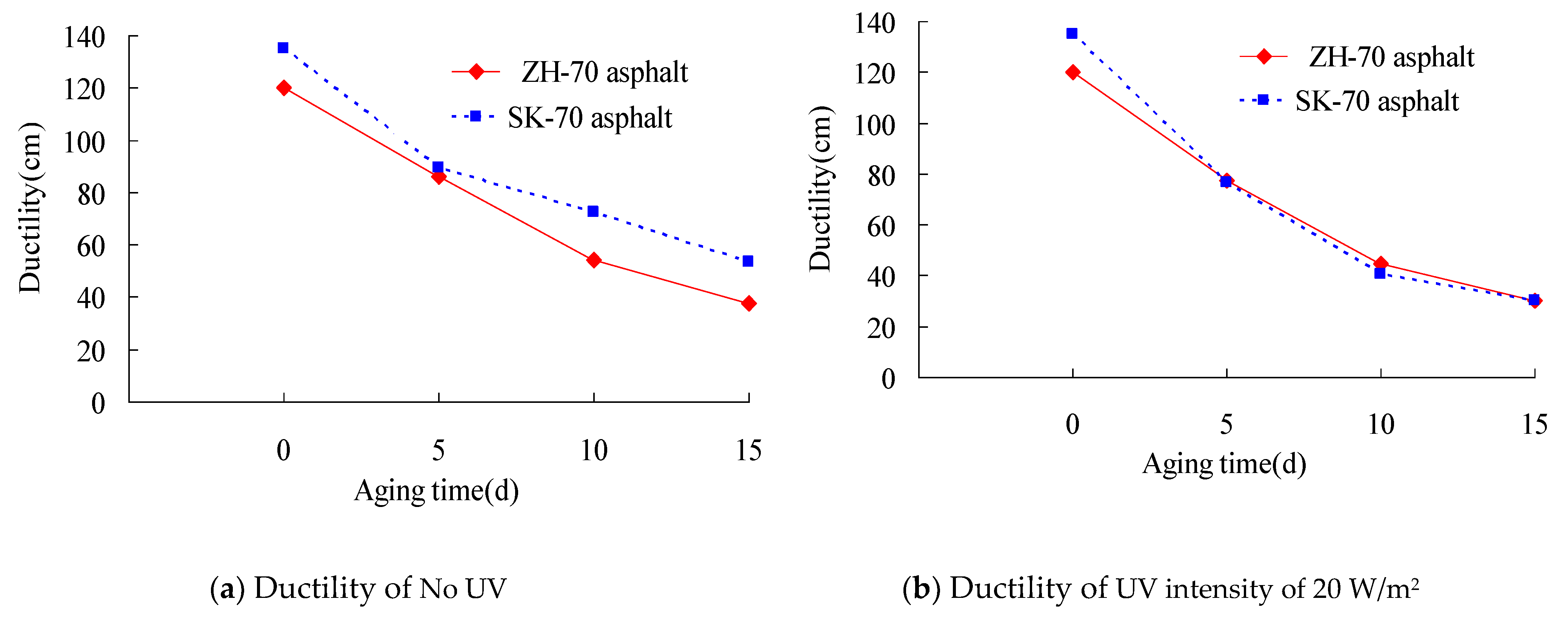
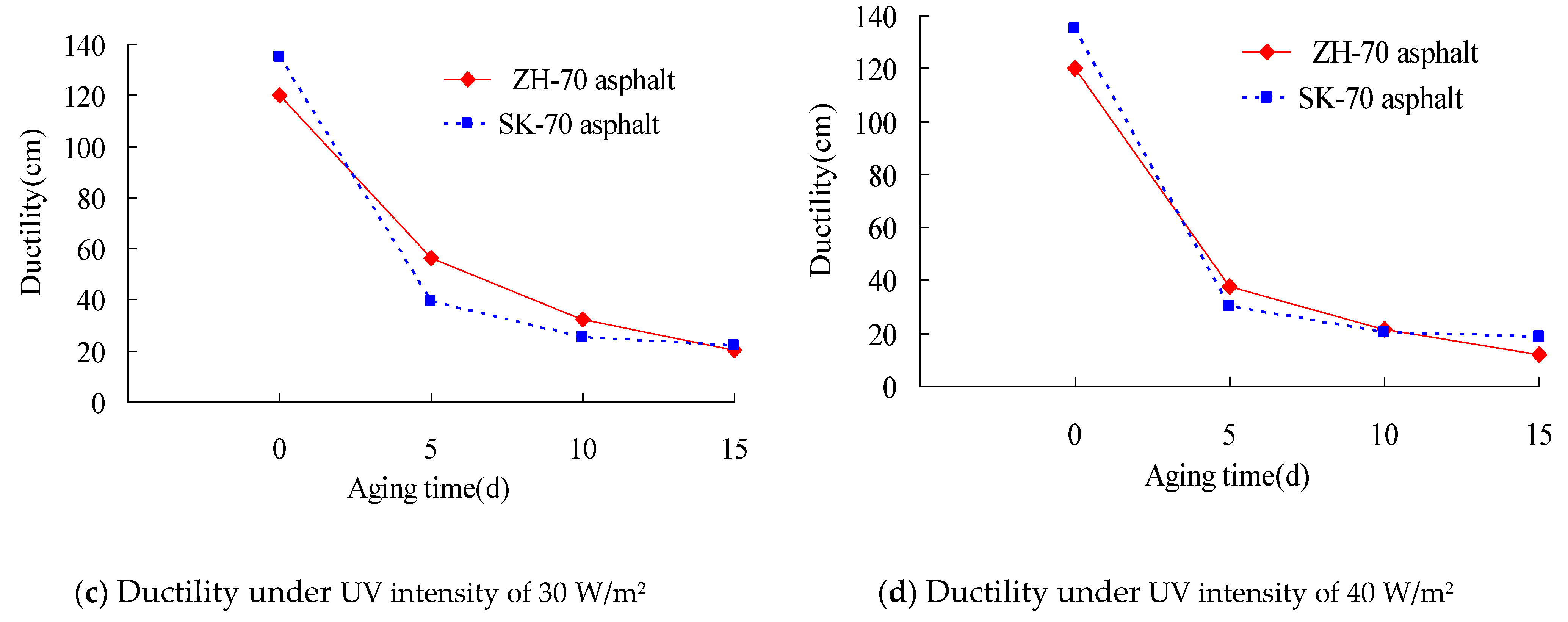
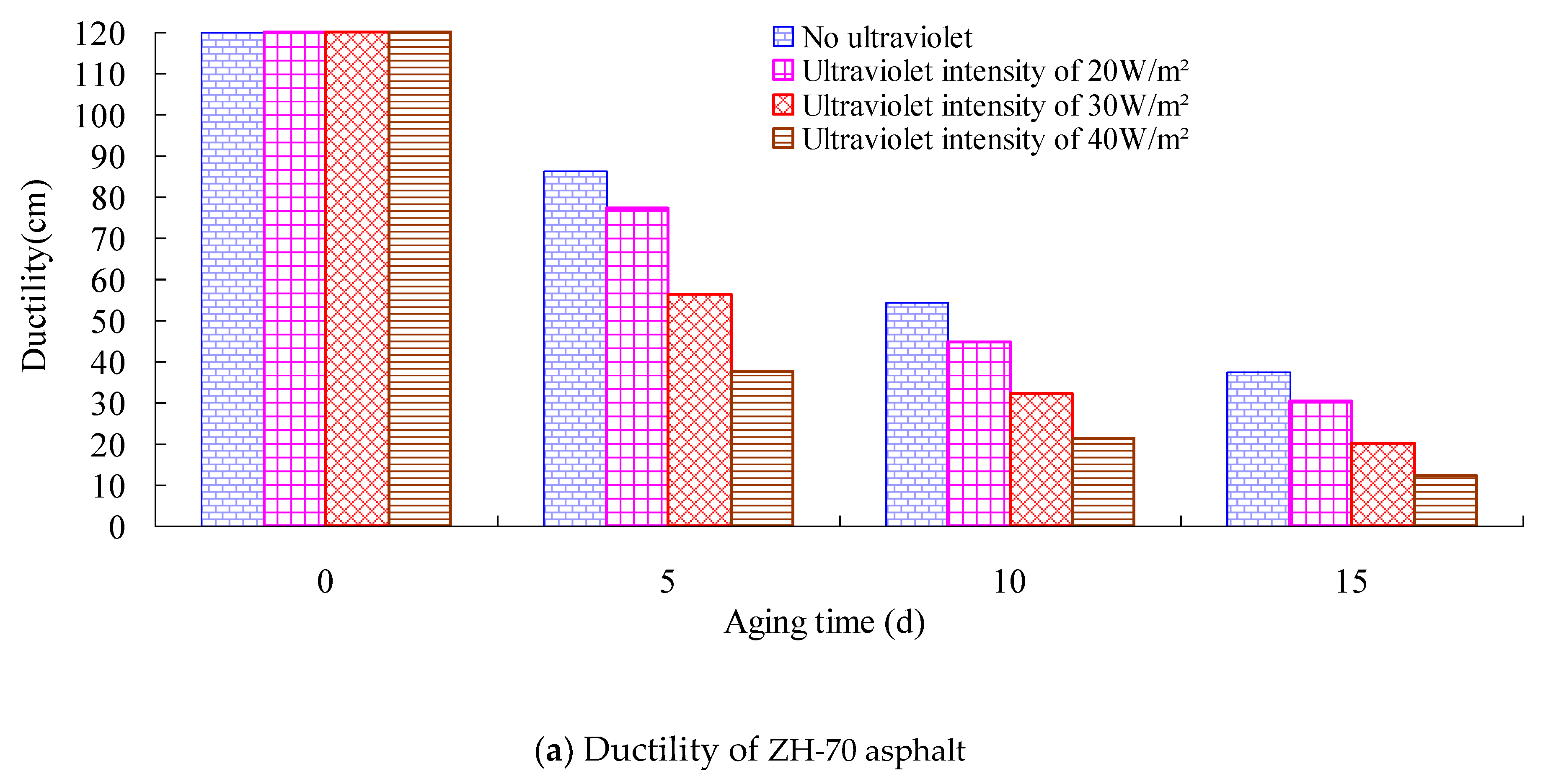
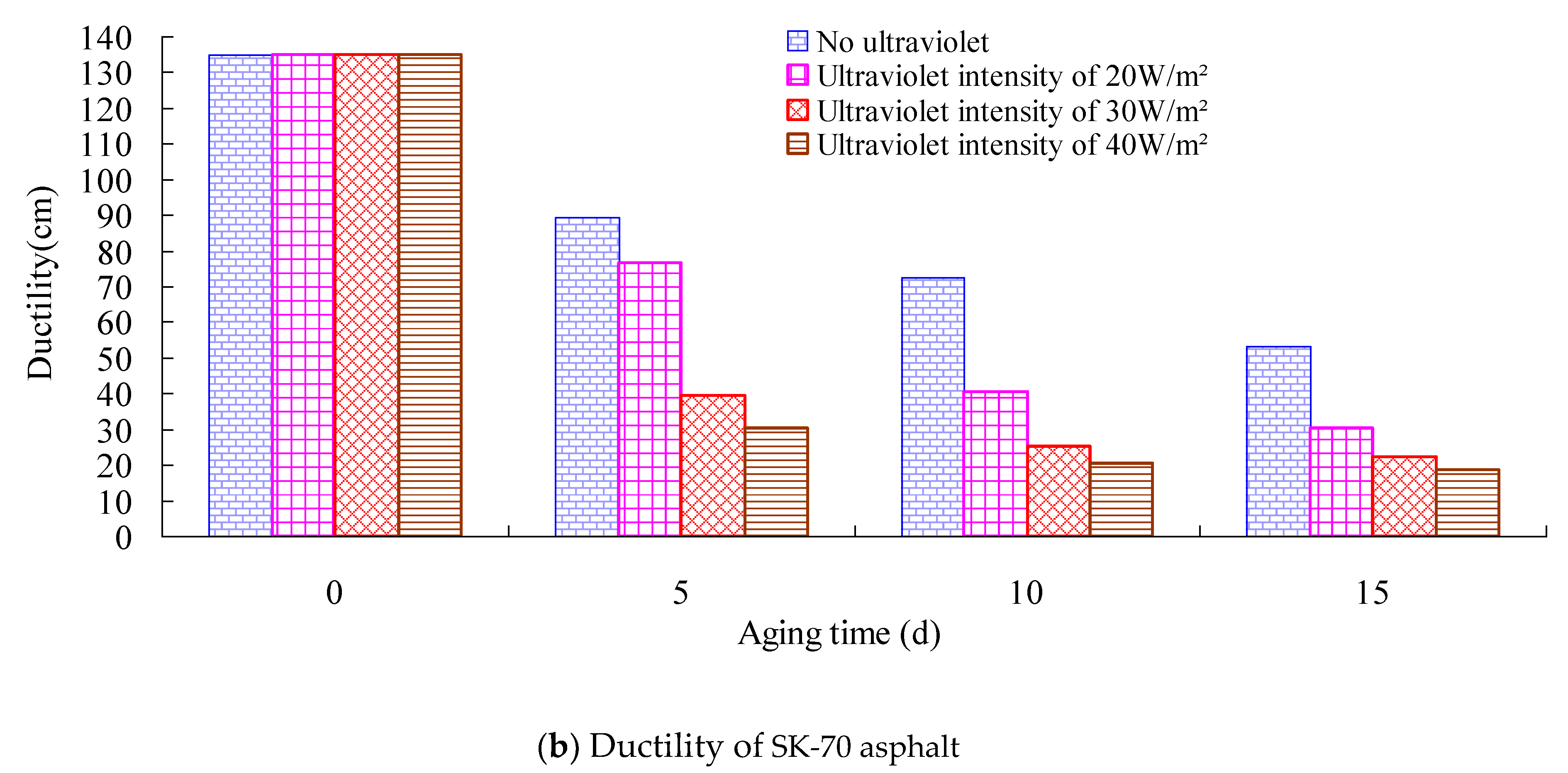
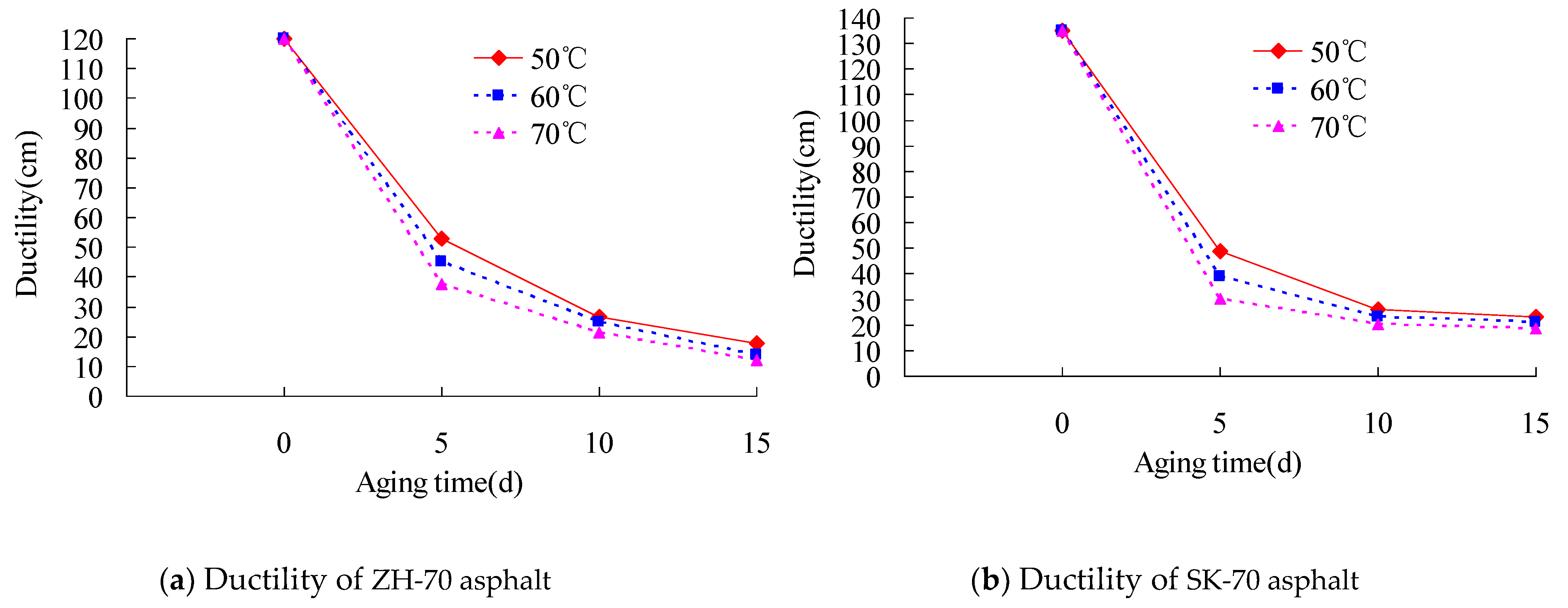
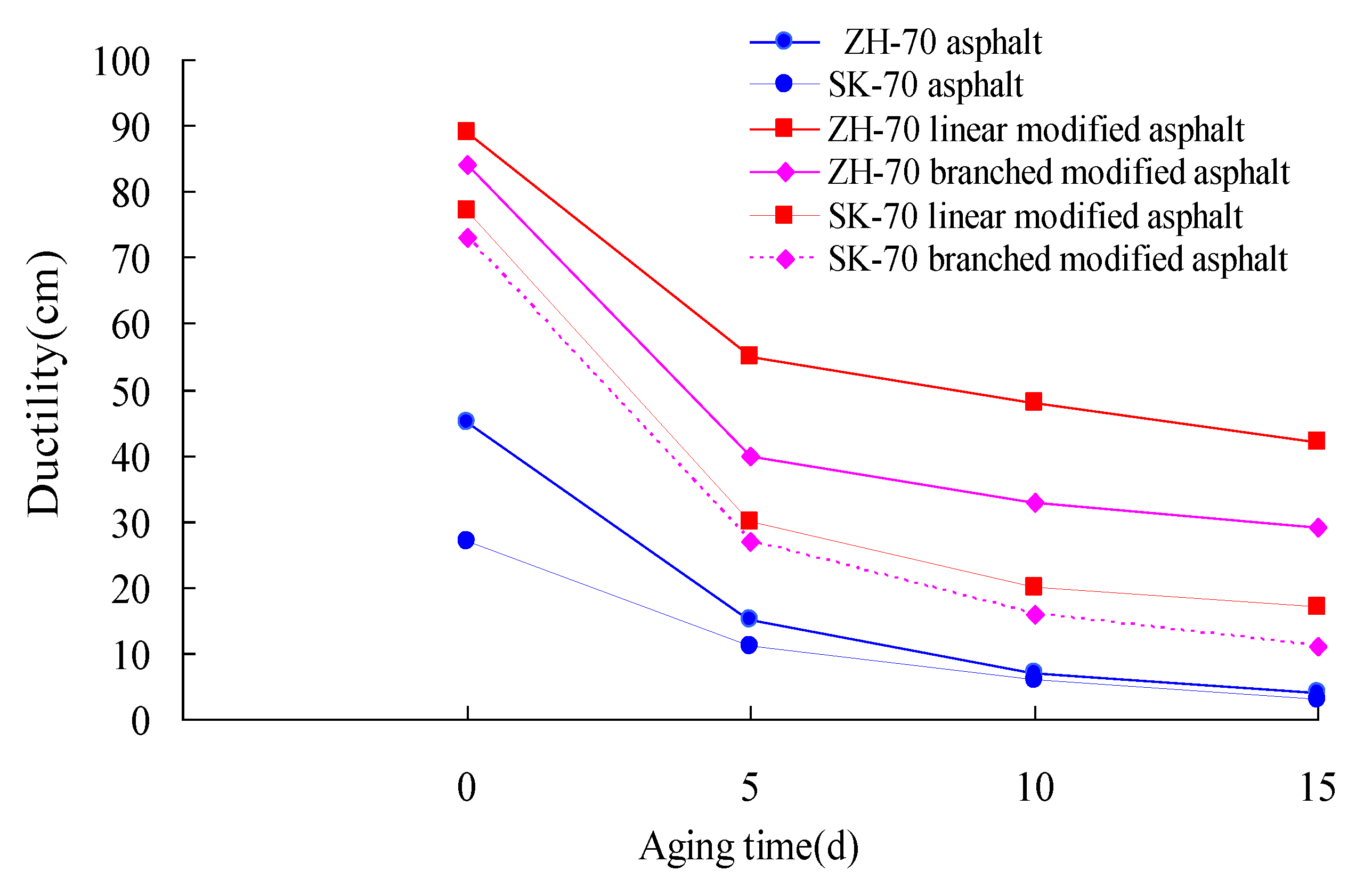
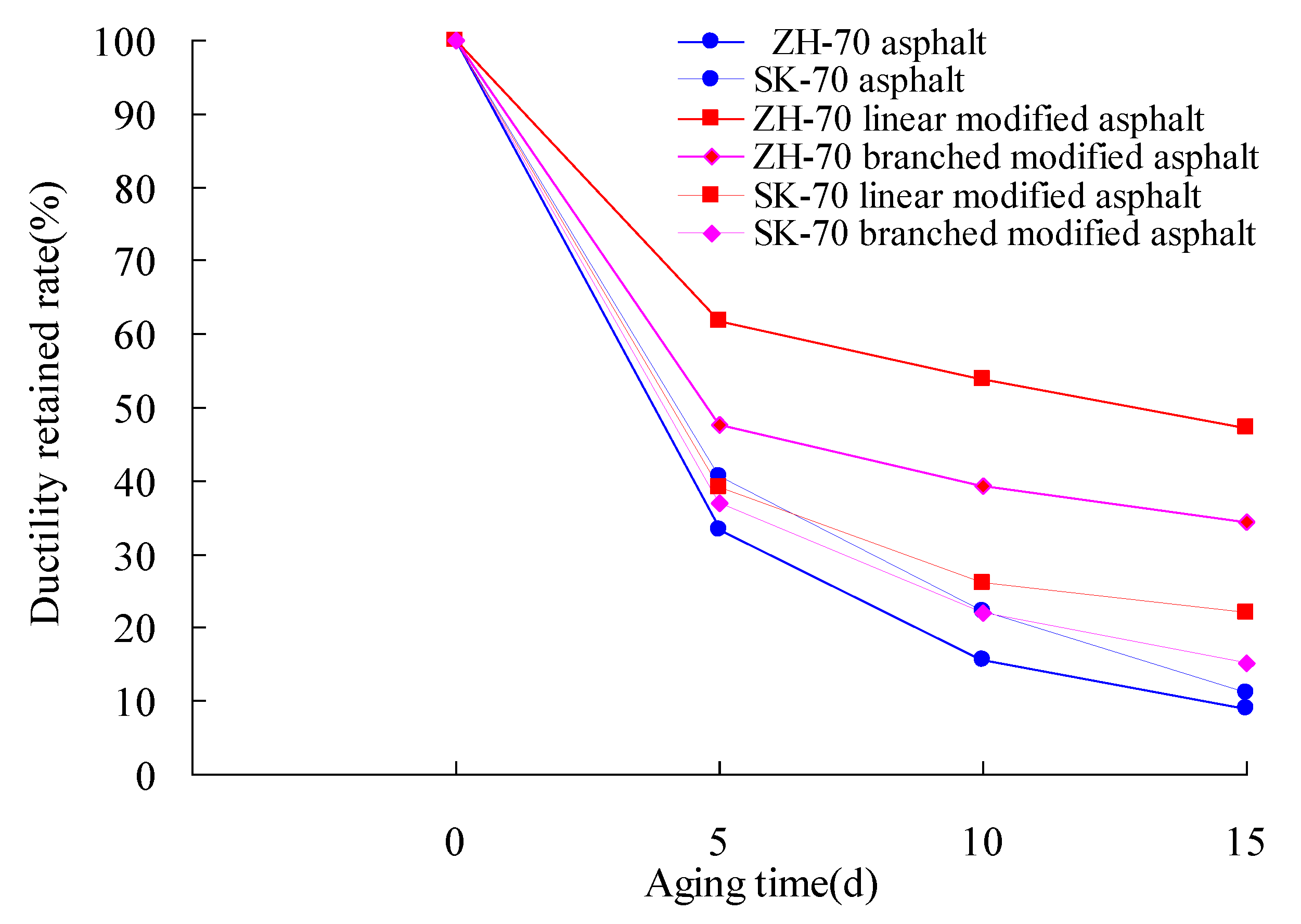
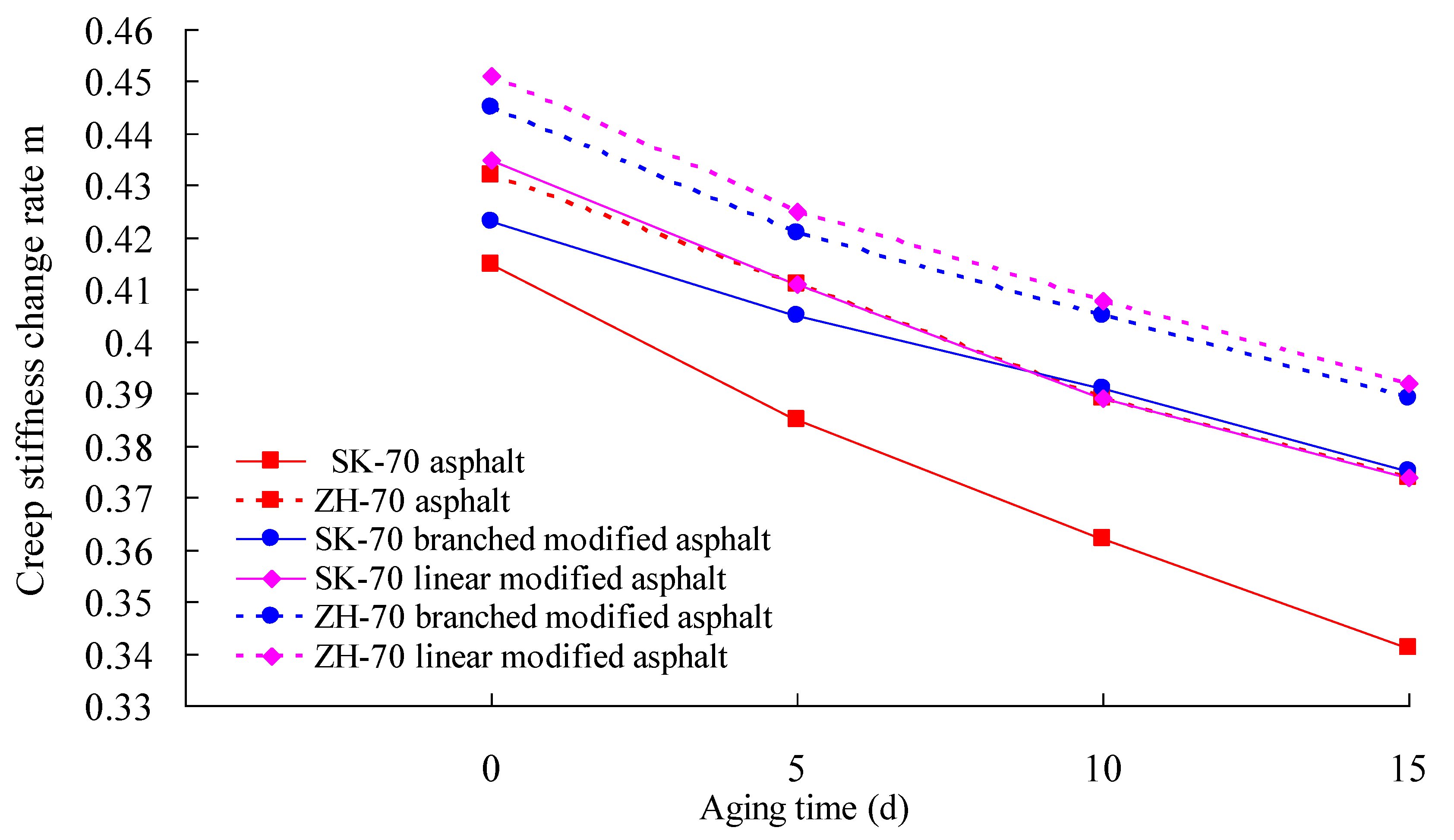
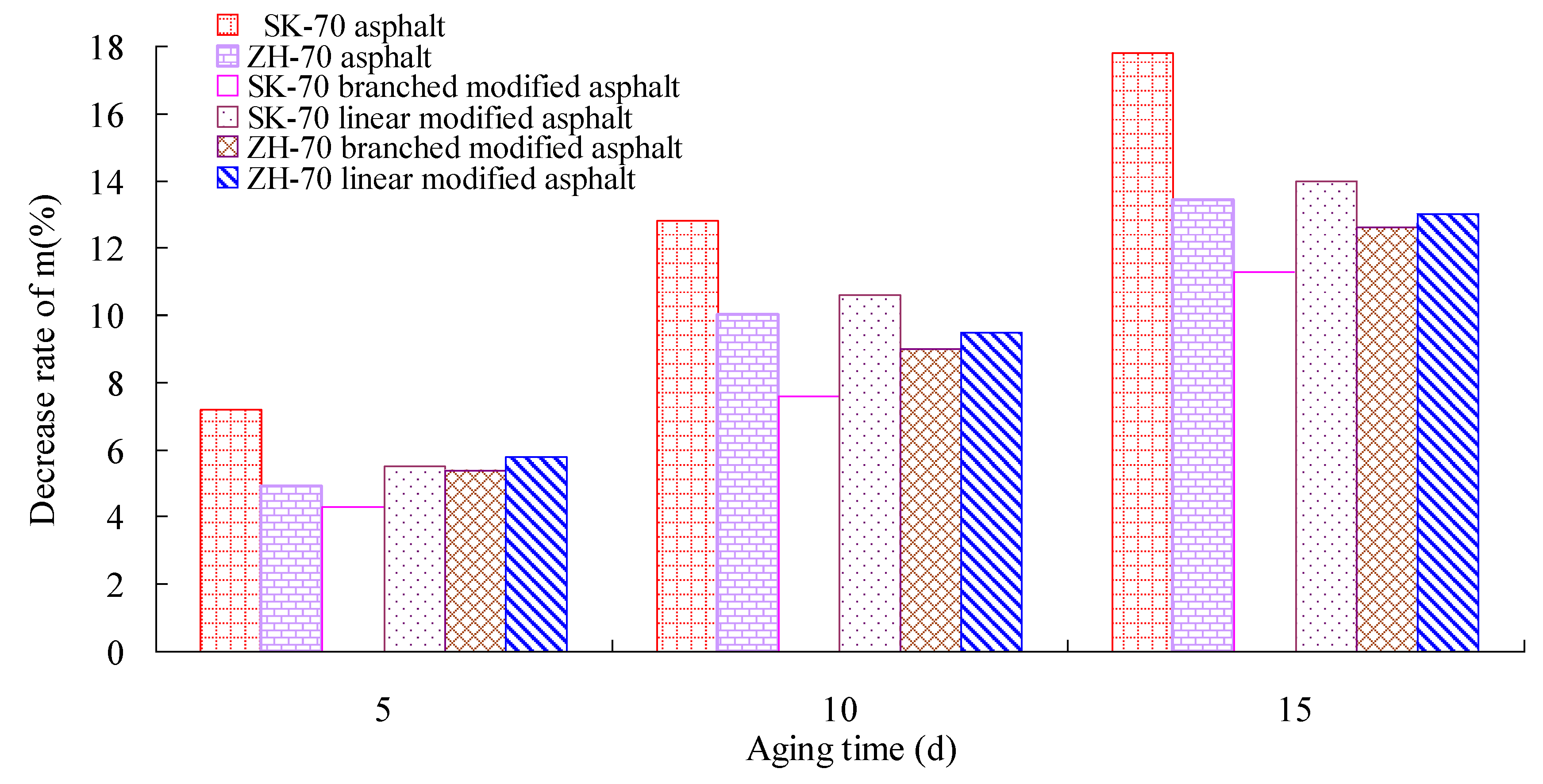
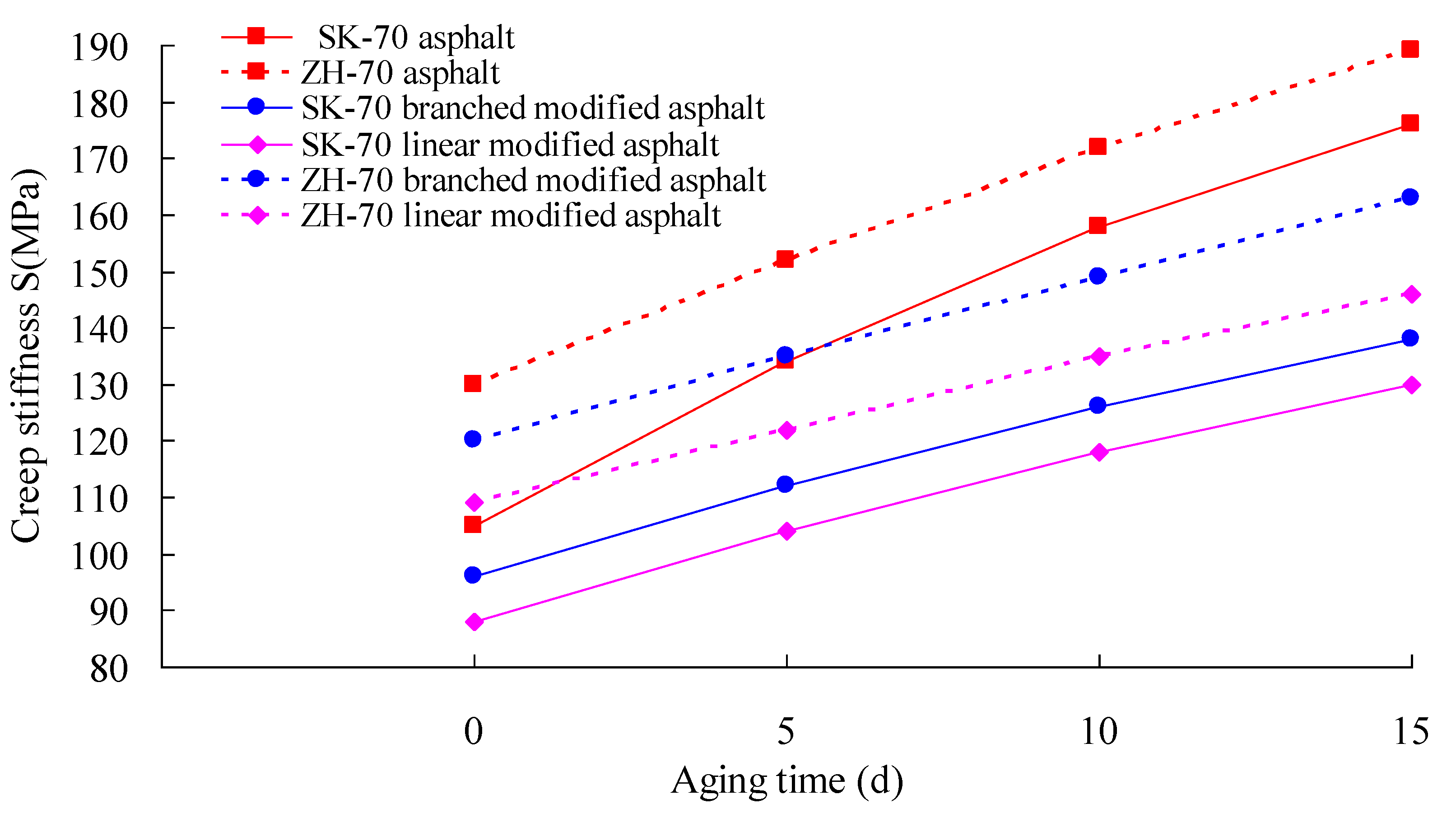
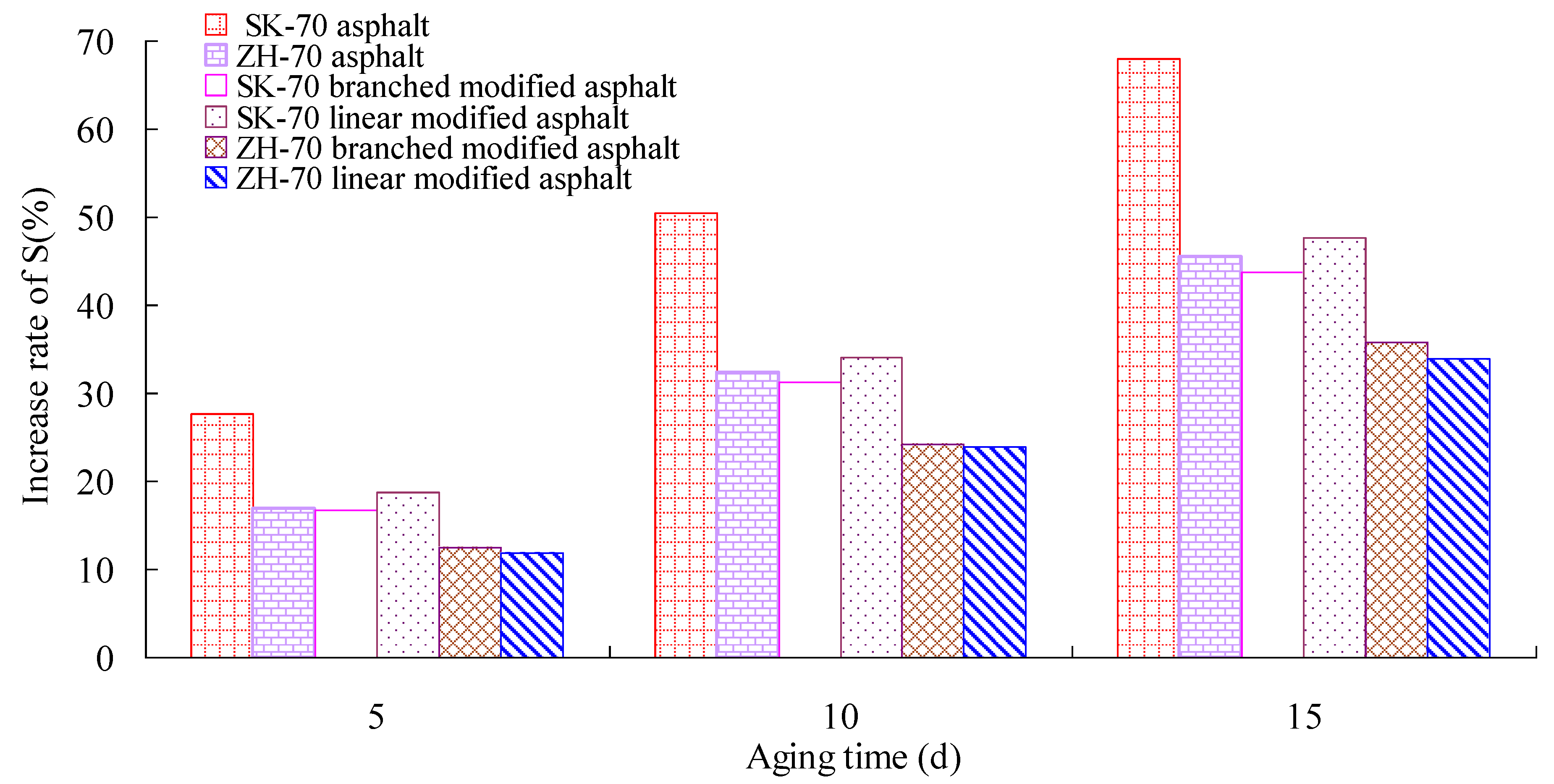
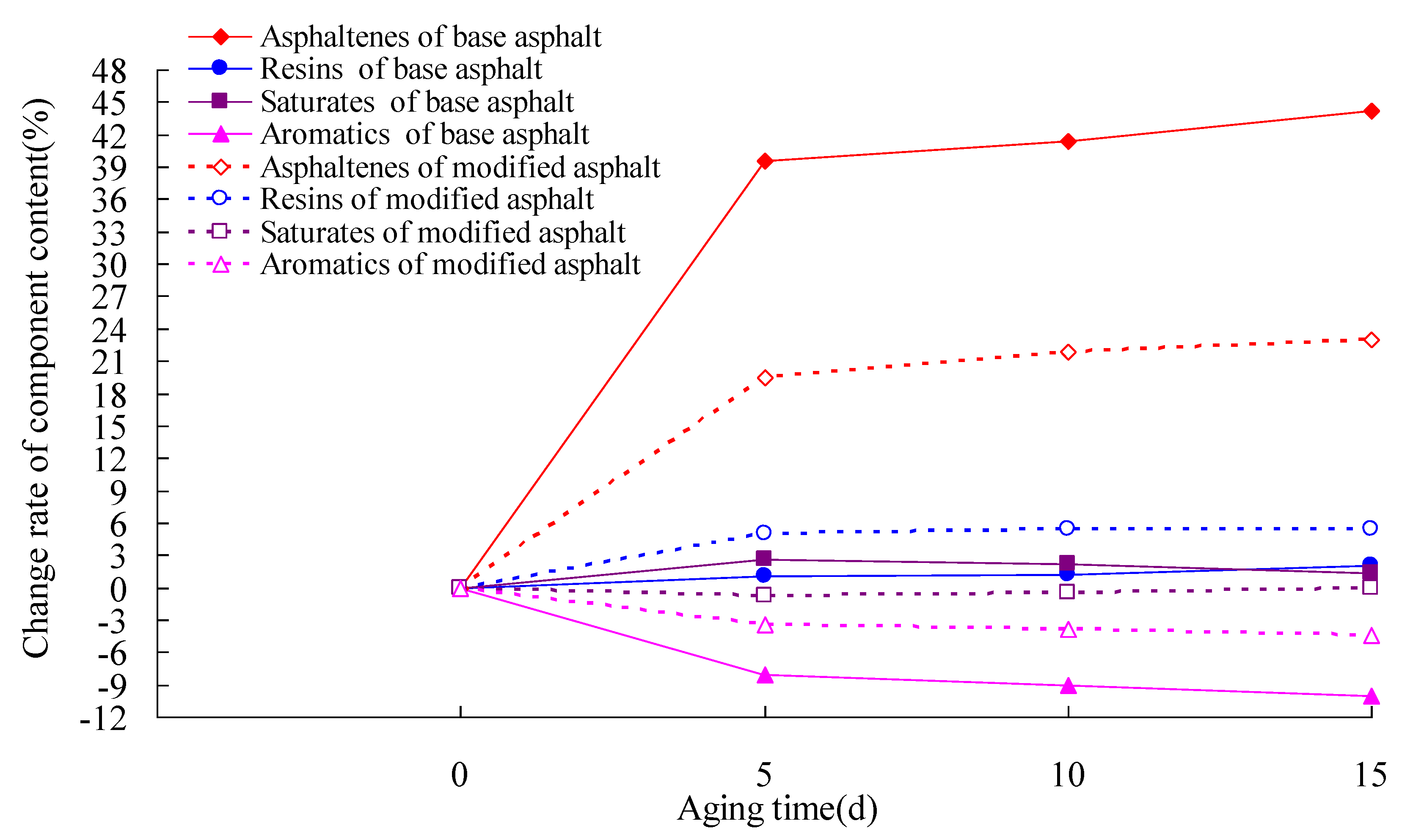
| Type | Elongation at Break (%) | Character | Permanent Set (%) | Tensile Strength (MPa) | Modulus at 300% Elongation (MPa) | Block Ratio |
|---|---|---|---|---|---|---|
| 501s modifier | ≥800 | White floc | ≤42 | ≥14.2 | ≥2.3 | 31/69 |
| 4402 modifier | ≥700 | White strip | ≤40 | ≥14.0 | ≥2.0 | 30/70 |
| Properties | Criteria | SK-70 | ZH-70 | Methods | |
|---|---|---|---|---|---|
| Ductility at 10 °C (cm) | ≥20 | 45 | 26.7 | T0604-2011 [22] | |
| Viscosity at 135 °C (Pa.s) | ≤3.0 | 0.554 | 0.632 | T0625-2011 [22] | |
| Rutting factor (kPa) | ≥1.0 | 1.91 | 1.20 | AASHTOT315 | |
| Penetration degree at 25 °C (0.1 mm) | 60~80 | 72 | 71 | T0605-2011 [22] | |
| Penetration index | −1.5 to +1.0 | 0.8 | 0.4 | T0604-2011 [22] | |
| Softening point (°C) | ≥47 | 48.4 | 48.6 | T0606-2011 [22] | |
| After the thin film oven test (TFOT) (163 °C, 5 h) | Mass loss (%) | ±0.8 | −0.3 | −0.14 | T0609-2011 [22] |
| Ductility at 10 °C (cm) | ≥6s | 16 | 26 | T0604-2011 [22] | |
| Penetration degree ratio at 25 °C (%) | ≥61 | 80.3 | 73.6 | T0605-2011 [22] | |
| Properties | Criteria | Linear-Modified Asphalt | Branched-Modified Asphalt | Methods | |||
|---|---|---|---|---|---|---|---|
| ZH-70 | SK-70 | ZH-70 | SK-70 | ||||
| Ductility at 10 °C (cm) | ≥20 | 89 | 84 | 77 | 73 | T0604-2011 [28] | |
| viscosity at 135 °C (Pa.s) | ≤3.0 | 1.625 | 1.400 | 1.853 | 1.769 | T0625-2011 [22] | |
| Rutting factor (kPa) | ≥1.0 | 2.23 | 2.35 | 1.86 | 1.97 | AASHTOT315 | |
| Penetration degree at 25 °C (0.1 mm) | 30~60 | 42 | 49 | 48 | 51 | T0605-2011 [28] | |
| Penetration index | ≥0 | 0.2 | 0.9 | 0.4 | 0.2 | T0604-2011 [28] | |
| Softening point (°C) | ≥ 60 | 61.5 | 63.2 | 60.5 | 62 | T0606-2011 [28] | |
| After the thin film oven test (TFOT) (163 °C, 5 h) | Mass loss (%) | ± 0.8 | 0.6 | −0.3 | −0.2 | −0.2 | T0609-2011 [28] |
| Ductility at 10 °C (cm) | ≥20 | 65 | 49 | 54 | 50 | T0604-2011 [28] | |
| Penetration degree ratio at 25 °C (%) | ≥65 | 85.7 | 83.7 | 81.3 | 73.4 | T0605-2011 [28] | |
| Aging Time | Saturates (%) | Aromatics (%) | Resins (%) | Asphaltenes (%) |
|---|---|---|---|---|
| 0 day | 13.35 | 49.28 | 28.32 | 9.05 |
| 5 days | 13.70 | 45.32 | 28.35 | 12.63 |
| 10 days | 13.65 | 44.91 | 28.64 | 12.80 |
| 15 days | 13.54 | 44.50 | 28.91 | 13.05 |
| Aging Time | Saturates (%) | Aromatics (%) | Resins (%) | Asphaltenes (%) |
|---|---|---|---|---|
| 0 day | 12.67 | 45.31 | 26.97 | 15.05 |
| 5 days | 12.58 | 43.82 | 25.62 | 17.98 |
| 10 days | 12.61 | 43.54 | 25.50 | 18.35 |
| 15 days | 12.67 | 43.33 | 25.49 | 18.51 |
© 2020 by the authors. Licensee MDPI, Basel, Switzerland. This article is an open access article distributed under the terms and conditions of the Creative Commons Attribution (CC BY) license (http://creativecommons.org/licenses/by/4.0/).
Share and Cite
Li, L.; Guo, Z.; Ran, L.; Zhang, J. Study on Low-Temperature Cracking Performance of Asphalt under Heat and Light Together Conditions. Materials 2020, 13, 1541. https://doi.org/10.3390/ma13071541
Li L, Guo Z, Ran L, Zhang J. Study on Low-Temperature Cracking Performance of Asphalt under Heat and Light Together Conditions. Materials. 2020; 13(7):1541. https://doi.org/10.3390/ma13071541
Chicago/Turabian StyleLi, Limin, Zhaoyang Guo, Longfei Ran, and Jiewen Zhang. 2020. "Study on Low-Temperature Cracking Performance of Asphalt under Heat and Light Together Conditions" Materials 13, no. 7: 1541. https://doi.org/10.3390/ma13071541
APA StyleLi, L., Guo, Z., Ran, L., & Zhang, J. (2020). Study on Low-Temperature Cracking Performance of Asphalt under Heat and Light Together Conditions. Materials, 13(7), 1541. https://doi.org/10.3390/ma13071541




